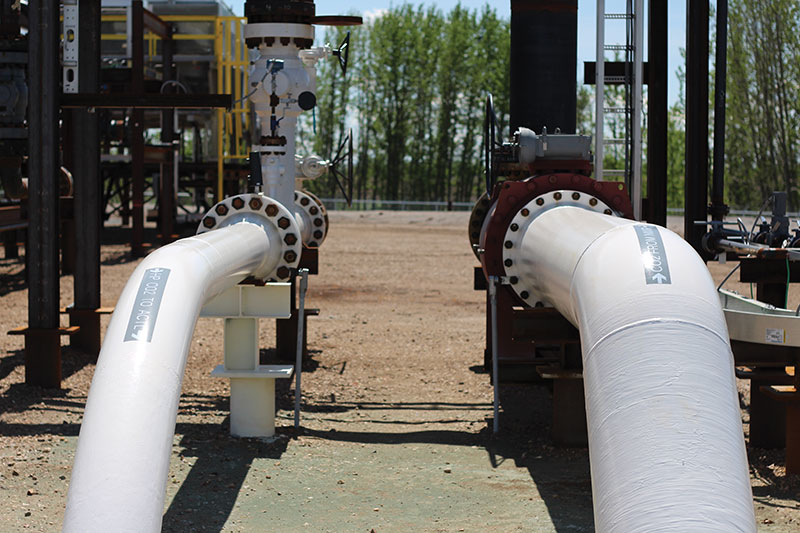November 2020, Vol. 247, No. 11
Features
Largest Capacity CO2 Pipeline Part of Expandable Capture, Storage System
Special to P&GJ
A new system built to safely transport and permanently store CO2 is shifting how carbon is managed in the province of Alberta, Canada. The Alberta Carbon Trunk Line (ACTL) system, the world’s newest large-scale carbon capture, utilization and storage (CCUS) project, is now fully operational.
The ACTL system captures industrial emissions and delivers CO2 to mature oil and gas reservoirs in Central Alberta for use in enhanced oil recovery (EOR) and permanent storage.
The current supply of CO2 is captured at the North West Redwater Partnership (NWR) Sturgeon Refinery and Nutrien’s Redwater Fertilizer Facility, offering a sustainable emissions solution for energy and agriculture sectors.
The CO2 then travels down a 150-mile (240-km) pipeline, which is owned by Alberta-based Wolf Midstream, to a storage reservoir owned by Enhance Energy. Wolf is the owner and operator of the compression facilities at the two capture sites, as well as the 15-mile (240-km) pipeline that safely transports the CO2 from the capture sites to the CO2 EOR operation in Central Alberta.
The system, consisting of three segments of pipeline – about 2 miles (3.2 km) of 24-inch (610-mm) pipe, 8 miles (13 km) of 12-inch (305-mm) pipe and a larger segment of 140 miles (225 km) of 16-inch (152-mm) pipe – includes the world’s largest capacity pipeline for CO2 from human activity. Designed as the backbone infrastructure needed to support Alberta’s lower carbon economy, it is capable of transporting up to 14.6 mtpa of CO2. This is equal to the impact of capturing the CO2 from more than 2.6 million cars, or 20% of all current oil sands emissions, in Alberta. Created with excess capacity, the system will connect more facilities and storage reservoirs in the future as demand increases for an effective solution to manage emissions.
“This is just the beginning,” said Jeff Pearson, president of Wolf Midstream’s Carbon Business Unit. “This critical piece of infrastructure supports significant future emissions solutions, new utilization pathways and innovation in the carbon capture space. The future of energy and a lower carbon economy relies on key infrastructure like the ACTL.”
“This will change how business is done in Alberta,” said Kevin Jabusch, CEO of Enhance Energy, which is injecting CO2 from the ACTL into oil fields near Clive, Alberta. “We are putting CO2 to use. We are permanently keeping CO2 out of the environment, while producing low-carbon energy. Not only are we reinvigorating our rural energy economy at a time when it is needed most, but we are playing a key role in advancing a sustainable solution to global energy requirements.”
“The Sturgeon Refinery made a bold decision over 15 years ago to incorporate carbon capture into its design,” said Kerry Margetts, president, NWR Sturgeon Refinery. “Our founders believed then, as we are proving today, that carbon capture was our environmental competitive advantage to producing a low-carbon-intensity diesel from Alberta’s bitumen resources.”
The ACTL system marks an important milestone project on the path for Alberta and Canada to effectively manage carbon emissions and support a cleaner global energy future.
Not only does the ACTL system remove greenhouse gas from the atmosphere and decrease
Canada’s carbon footprint, it uses the captured CO₂ to revitalize a light oil industry, leveraging Alberta’s wealth of suitable storage reservoirs, technical expertise and innovative spirit to create thousands of new jobs, and generate meaningful tax revenue.
The multifaceted ACTL system is owned and operated by a consortium of companies. It has also been supported by both the Government of Alberta (through its Carbon Capture and Storage Fund) and the Government of Canada (through its ecoEnergy Technology Initiative and the Clean Energy Fund) to help make CCUS technologies more accessible and encourage wider use of the technology around the world.
“We’re kind of on the home stretch in a sense,” Wolf Midstream’s Cullen Colville, manager, Project Engineering, told P&GJ last year. “Right now, we’re expecting the pipe we need to be in the ground by the end of October.”
While construction of the project took place in largely rural areas, averting the kind of challenges brought on by dense population and traffic concerns, the ACTL project found its biggest foe to be the weather.
“This has been a very difficult year to construct with the amount of precipitation we’ve had. It has been completely abnormal and above average,” Colville said. “And, of course, when you have a linear disturbance that’s covering several hundred kilometers, good weather is the name of the game.”
In addition to the heavy precipitation in the spring and fall, February brought record low temperatures to the province, causing frozen ground and the need to “demonstrate a little bit of agility,” he added.






Comments